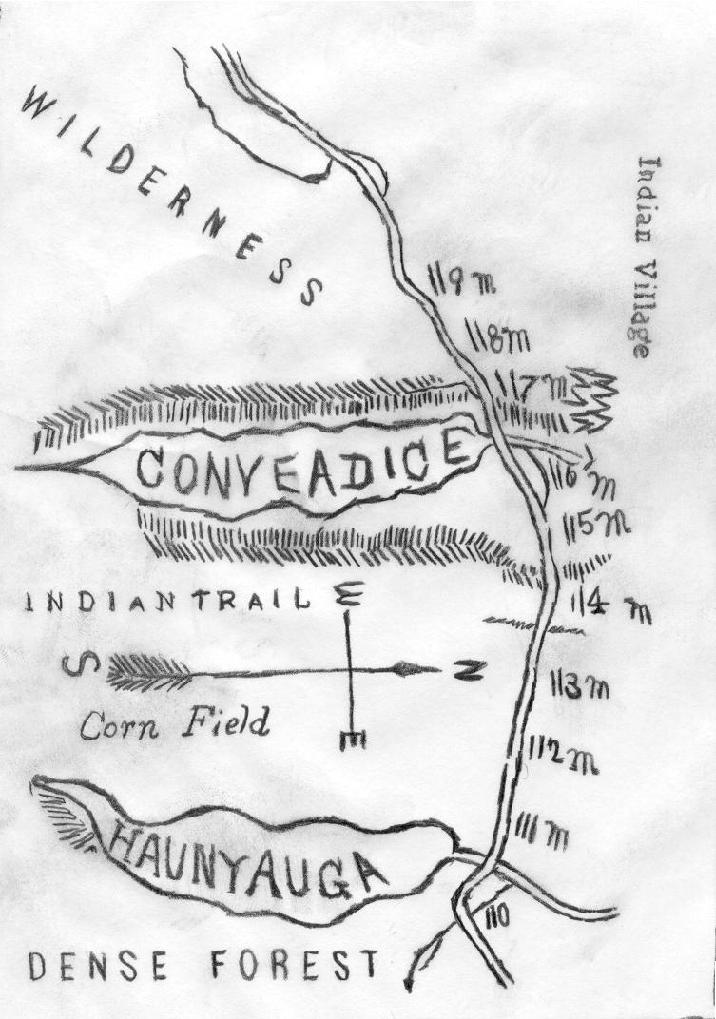HISTORY OF CANADICE
Sullivan's Campaign
Sullivan's Campaign
Chapter 2
SULLIVAN'S CAMPAIGN
In the summer of 1779, General John Sullivan and his 5,000 Continentals instilled into the Iroquois mind an appreciation for the strength of the Patriot cause. He taught the red man that the arm of General Washington was long to reach and strong to punish those who chose to do the bloody work of the Tories. The destruction of forty or more populous and well built villages, numerous ripening fields of grain and large orchards taught a lesson never to be forgotten.
At Honeoye, the Yankee general left a garrison of fifty men with a cannon. These men built a stockade called Fort Cumming, named after their leader. In the center of the village, and later moved to the school property, a monument commemorating the fort built there in 1779, with the notation that "Here were left the sick, the lame and the lazy" of the Sullivan expedition.
It is assumed that General Sullivan crossed the northern end of the town of Canadice when he passed through the Seneca country crossing Canadice outlet about a mile north of the lake. It is true, Sullivan's historians say, that at Honeoye he left a small force to guard the sick and the provisions, and advanced with the utmost caution to the head of Lake Conesus. It is inferred by historians of a later date that it took his army but one day only to march that distance, cutting his way through the forest. Also that the skirmish took place in the afternoon of the same day, before the encampment of the army at the inlet of Conesus Lake.
John Salmon, a former resident of Groveland, who accompanied the expedition, said, "From the mouth of the Seneca Lake, we proceeded without the occurrence of anything important by the outlets of Canandaigua, Honeoye and Hemlock Lakes to the head of Conesus Lake," saying nothing about the time engaged and making no mention whatever to Canadice Lake. The point at which it is claimed he crossed the outlet of Canadice is about a mile from the foot of the lake. Sullivan's silence on that point is not to be taken as proof that he did cross at that point.
Stone, in his book, The Life of Colonel Joseph Brant, about the Mohawk Chief, stated distinctly that it took Sullivan's army two days march from the foot of Honeoye Lake to the inlet of the Conesus. Rufus Gray, who accompanied the expedition and was afterwards an early settler in Canadice, is quite positive on the subject and agreed they crossed about a mile from the foot of the lake.
In about 1824, Hiram Colegrove, then living on his farm about a mile below the foot of Canadice Lake, found on his property a light axe, an old crumpled shoe undoubtedly worn by one of Sullivan's men, a scalping knife, a kind of pruning knife, an unwieldy pistol and a whiskey flask with the inscriptions "1775" and "Old Rye."
These article were shown Gray and although the axe, pistol and knives were badly rusted, he recognized them at once as belonging to Sullivan's men. He visited the place where they were found and also recognized that as the "identical spot where they camped the first night after leaving the foot of the Honeoye." He said he fully recollected that it took two whole days to reach the battlefield at the head of the Conesus after leaving the Indian village at the foot of the Honeoye.
At the location where they crossed the outlet of the Canadice, they cut down trees and made a causeway over which to ford their pieces of artillery. At that very point, Colegrove has since plowed up pieces of logs which had the position and appearance of having been placed there for that purpose.
Rufus Gray says they crossed the outlet on the west side. He also pointed out the route they took from there to the foot of Hemlock Lake, passing west up the hill near the old residence of the late David Hoppaugh, and across the farm now owned by Augustus Shepard, to the eastern shore of the lake, about three-fourths of a mile above the foot. Thence, down the lake to what were called in after years, "Shorts Flats." Here they found large fields of corn and beans planted, which they pulled up and trampled down.
After crossing the outlet of Hemlock Lake, they proceeded in a direct route to the head of Conesus and encountered a skirmish in the afternoon of the second day following the day of their departure from Honeoye.
